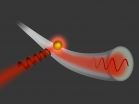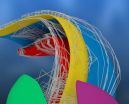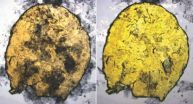(Press-News.org) This news release is available in German.
How can a beam of light tell the difference between left and right? At the Vienna University of Technology (TU Wien) tiny particles have been coupled to a glass fibre. The particles emit light into the fibre in such a way that it does not travel in both directions, as one would expect. Instead, the light can be directed either to the left or to the right. This has become possible by employing a remarkable physical effect – the spin-orbit coupling of light. This new kind of optical switch has the potential to revolutionize nanophotonics. The researchers have now published their work in the journal "Science".
Gold Nanoparticles on Glass Fibres
When a particle absorbs and emits light, this light is not just emitted into one direction. "A particle in free space will always emit as much light into one particular direction as it emits into the opposite direction", says Professor Arno Rauschenbeutel (TU Wien). His team has now succeeded in breaking this symmetry of emission using gold nanoparticles coupled to ultra-thin glass fibres. The incident laser light determines whether the light emitted by the particle travels left or right in the glass fibre.
Bicycles and Airplane Propellers
This is only possible because light has an intrinsic angular momentum, the spin. Similar to a pendulum which can swing in one particular plane or move in circles, a light wave can have different directions of oscillation. If it has a well-defined vibrational direction, it is called a "polarized wave". "A simple plane wave has the same polarization everywhere", says Arno Rauschenbeutel, "but when the intensity of the light changes locally, the polarization changes too."
Usually, the light oscillates in a plane perpendicular to its direction of propagation. If the oscillation is circular, this is similar to the motion of an airplane propeller. Its rotational axis – corresponding to the spin – points into the direction of propagation. But light moving through ultra-thin glass fibres has very special properties. Its intensity is very high inside the glass fibre, but it rapidly decreases outside the fibre. "This leads to an additional field component in the direction of the glass fibre", says Arno Rauschenbeutel. The rotational plane of the light wave pivots by 90 degrees. "Then, the direction of propagation is perpendicular to the spin, just like a bicycle, moving into a direction which is perpendicular to the axes of the wheels."
By checking the wheels' direction of rotation – clockwise or counter-clockwise – we can tell whether a bicycle moves right or left when looking at it from the side. It is exactly the same with the beams of light in the ultra-thin glass fibre. The sense of rotation of the light field is coupled to the direction of motion. This kind of coupling is a direct consequence of the glass fibre geometry and the laws of electrodynamics. The effect is called "spin-orbit-coupling of light".
Coupling Rotation and the Direction of Motion
When a particle that is coupled to the glass fibre is irradiated with a laser in such a way that it emits light of a particular sense of rotation, the emitted light will thus propagate into just one particular direction inside the glass fibre – either to the left or to the right. This effect has now been demonstrated using a single gold nanoparticle on a glass fibre. The fibre is 250 times thinner than a human hair; the diameter of the gold particle is even four times less. Both the diameter of the fibre and the particle are even smaller than the wavelength of the emitted light.
"This new technology should be easily made available in commercial applications. Already now, the whole experiment fits into a shoebox", says Arno Rauschenbeutel. "The method could be applied to integrated optical circuits. Such systems may one day replace the electronic circuits we are using today."
INFORMATION:
Original publication: http://www.sciencemag.org/content/346/6205/67.abstract?sid=b4232f8f-8ae8-4695-baeb-3c98aed27672
Further information
Prof. Arno Rauschenbeutel
Atominstitut
Vienna Center for Quantum Science and Technology
Technische Universität Wien
Stadionallee 2, 1020 Wien
T: +43-(1)-58801-141761
arno.rauschenbeutel@tuwien.ac.at
Nanoparticles break the symmetry of light
Nanoparticles can emit light into ultra-thin glass fibers; physicists at the Vienna University of Technology have now managed to select the direction of the light using an unusual kind of coupling between spin and the direction of propagation
2014-10-06
ELSE PRESS RELEASES FROM THIS DATE:
Tumors might grow faster at night
2014-10-06
They emerge at night, while we sleep unaware, growing and spreading out as quickly as they can. And they are deadly. In a surprise finding that was recently published in Nature Communications, Weizmann Institute of Science researchers showed that nighttime is the right time for cancer to grow and spread in the body. Their findings suggest that administering certain treatments in time with the body's day-night cycle could boost their efficiency.
This finding arose out of an investigation into the relationships between different receptors in the cell – a complex network ...
Researchers redefine hypothesis on holes in the brain
2014-10-06
Over the years, researchers have described how some of the body's cells have giant channels – a kind of holes that completely uncritically allow both small and large molecules to penetrate into and out of the cell. The hypothesis is that these normally closed gatekeeper proteins in the cell membrane allow unrestricted access in the event of diseases such as myocardial infarction, stroke or Alzheimer's. If the hypothesis was correct, the obvious choice would be to look for novel drugs to block the relevant membrane proteins and in this way cure or prevent disease.
New ...
Tracing our ancestors at the bottom of the sea
2014-10-06
A specialist group of European researchers are studying the remains of prehistoric human settlements which are now submerged beneath our coastal seas. Some of these drowned sites are tens of thousands of years old. From the progressive discovery and analysis of these prehistoric remains, a new scientific field has emerged, combining the expertise from many disciplines including archaeology, oceanography and the geosciences. The new field is called Continental Shelf Prehistoric Research.
This rapidly evolving research field is the focus of a new European Marine Board ...
MFM specialists contribute to Clinical Expert Series in Obstetrics & Gynecology
2014-10-06
Since the first human fetal surgery was reported in 1965, several different fetal surgical procedures have been developed and perfected, resulting in significantly improved outcomes for many fetuses. However, the significant investments associated with this highly specialized service and quality metrics must be considered as more fetal treatment programs are developed.
Katharine D. Wenstrom, MD, director of the Division of Maternal-Fetal Medicine at Women & Infants Hospital of Rhode Island, co-director of the hospital's Integrated Program for High-Risk Pregnancy, and ...
Why does toothpaste make orange juice taste awful? (video)
2014-10-06
WASHINGTON, Oct. 6, 2014 — It's happened to many of us: Half asleep in the morning, you finish brushing your teeth and reach for your daily glass of orange juice. After taking a big swig, you spit it back out, making a face like you've just chewed on a lemon. Turns out, a specific chemical in your toothpaste is responsible for that nasty taste. This week, Reactions explains why toothpaste and orange juice don't mix. Learn all about it at https://www.youtube.com/watch?v=9X5_gtel-c0.
Subscribe to the series at Reactions YouTube, and follow us on Twitter @ACSreactions to ...
Pressing the accelerator on quantum robotics
2014-10-06
Quantum computing will allow for the creation of powerful computers, but also much smarter and more creative robots than conventional ones. This was the conclusion arrived at by researchers from Spain and Austria, who have confirmed that quantum tools help robots learn and respond much faster to the stimuli around them.
Quantum mechanics has revolutionised the world of communications and computers by introducing algorithms which are much quicker and more secure in transferring information. Now researchers from the Complutense University of Madrid (UCM) and the University ...
A glimpse into the 3-D brain: How memories form
2014-10-06
The way neurons are interconnected in the brain is very complicated. This holds especially true for the cells of the hippocampus. It is one of the oldest brain regions and its form resembles a see horse (hippocampus in Latin). The hippocampus enables us to navigate space securely and to form personal memories. So far, the anatomic knowledge of the networks inside the hippocampus and its connection to the rest of the brain has left scientists guessing which information arrived where and when.
Signals spread through the brain
Accordingly, Dr Martin Pyka and his colleagues ...
No need for water, enzymes are doing it for themselves
2014-10-06
New research by scientists at the University of Bristol has challenged one of the key axioms in biology - that enzymes need water to function. The breakthrough could eventually lead to the development of new industrial catalysts for processing biodiesel.
Enzymes are large biological molecules that catalyse thousands of different chemical reactions that are essential for all life, from converting food into energy, to controlling how our cells replicate DNA.
Throughout this diverse range of biological environments in which enzymes perform their various roles, the only ...
Research paves way for new generation of fungicides
2014-10-06
Plants that come under attack from pathogens have an automatic immune response. Fungi get around this plant immunity by injecting proteins into the host plant cells. These 'effector proteins' enable the fungi to escape the plant's immune system and allow the fungal cells to enter the plant unrecognised.
Exeter scientists have now shown that signalling organelles, known as 'early endosomes' act as long distance messengers in the fungi. They travel rapidly along long tube-like cells between the plant-invading fungal cell tip and the fungal cell nucleus. This rapid communication ...
Online games and remote experiments could reduce scientific fraud, cherry-picking
2014-10-06
PITTSBURGH—One way to combat the rising level of errors and fraud in life sciences research is through massive online laboratories, which use videogames to engage large numbers of non-professional investigators and prevent scientists from manually testing their own hypotheses, researchers from Carnegie Mellon University and Stanford University say.
Though unconventional, CMU's Adrien Treuille and Stanford's Rhiju Das argue that this online, game-like approach actually is more scientifically rigorous than the standard practice of scientists proposing an explanation for ...
LAST 30 PRESS RELEASES:
Interaction of climate change and human activity and its impact on plant diversity in Qinghai-Tibet plateau
From addressing uncertainty to national strategy: an interpretation of Professor Lim Siong Guan’s views
Clinical trials on AI language model use in digestive healthcare
Scientists improve robotic visual–inertial trajectory localization accuracy using cross-modal interaction and selection techniques
Correlation between cancer cachexia and immune-related adverse events in HCC
Human adipose tissue: a new source for functional organoids
Metro lines double as freight highways during off-peak hours, Beijing study shows
Biomedical functions and applications of nanomaterials in tumor diagnosis and treatment: perspectives from ophthalmic oncology
3D imaging unveils how passivation improves perovskite solar cell performance
Enriching framework Al sites in 8-membered rings of Cu-SSZ-39 zeolite to enhance low-temperature ammonia selective catalytic reduction performance
AI-powered RNA drug development: a new frontier in therapeutics
Decoupling the HOR enhancement on PtRu: Dynamically matching interfacial water to reaction coordinates
Sulfur isn’t poisonous when it synergistically acts with phosphine in olefins hydroformylation
URI researchers uncover molecular mechanisms behind speciation in corals
Chitin based carbon aerogel offers a cleaner way to store thermal energy
Tracing hidden sources of nitrate pollution in rapidly changing rural urban landscapes
Viruses on plastic pollution may quietly accelerate the spread of antibiotic resistance
Three UH Rainbow Babies & Children’s faculty elected to prestigious American Pediatric Society
Tunnel resilience models unveiled to aid post-earthquake recovery
Satellite communication systems: the future of 5G/6G connectivity
Space computing power networks: a new frontier for satellite technologies
Experiments advance potential of protein that makes hydrogen sulfide as a therapeutic target for Alzheimer’s disease
Examining private equity’s role in fertility care
Current Molecular Pharmacology achieves a landmark: real-time CiteScore advances to 7.2
Skeletal muscle epigenetic clocks developed using postmortem tissue from an Asian population
Estimating unemployment rates with social media data
Climate policies can backfire by eroding “green” values, study finds
Too much screen time too soon? A*STAR study links infant screen exposure to brain changes and teen anxiety
Global psychiatry mourns Professor Dan Stein, visionary who transformed mental health science across Africa and beyond
KIST develops eco-friendly palladium recovery technology to safeguard resource security
[Press-News.org] Nanoparticles break the symmetry of lightNanoparticles can emit light into ultra-thin glass fibers; physicists at the Vienna University of Technology have now managed to select the direction of the light using an unusual kind of coupling between spin and the direction of propagation






